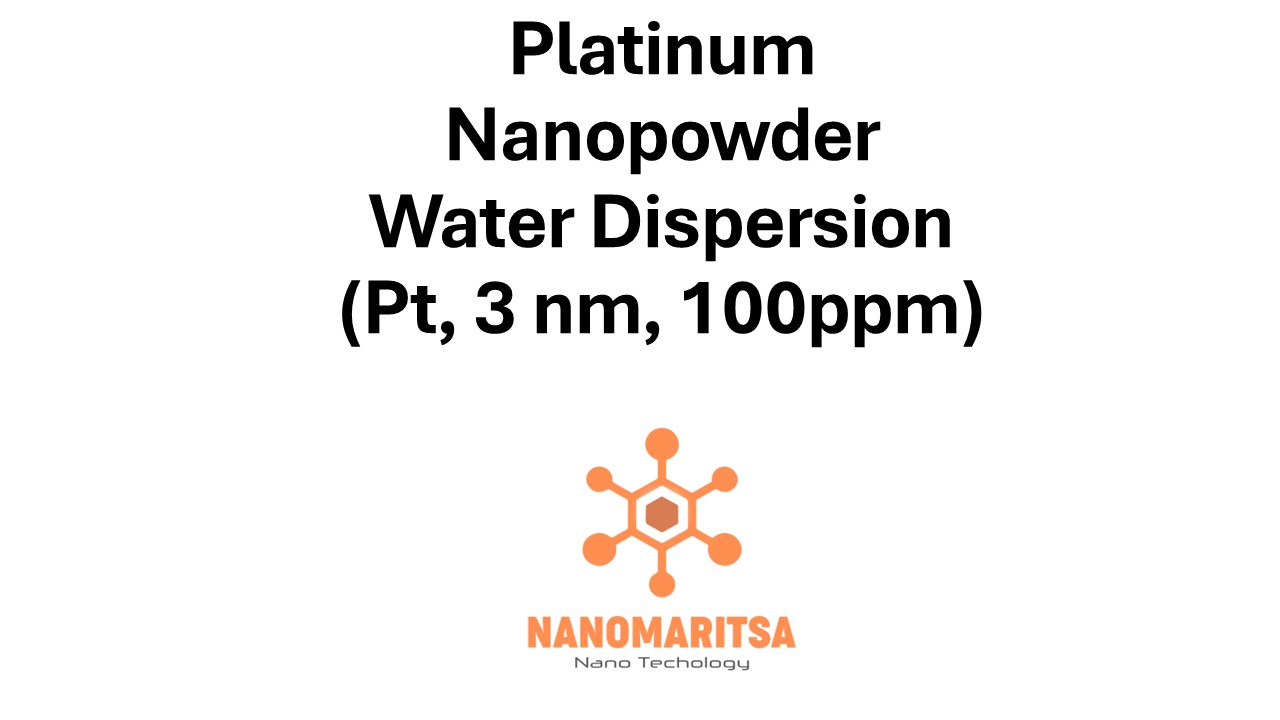Platinum Nanopowder Water Dispersion (Pt, 3 nm, 100ppm) is a concentrated colloidal solution of platinum nanoparticles suspended in water. Here’s a detailed breakdown of its key features and applications:
- Key Features:
- Platinum (Pt): The primary material is platinum, a precious metal renowned for its excellent catalytic properties, corrosion resistance, and stability in various chemical environments.
- Nanoparticles: The platinum particles have an average size of 3 nanometers (nm), providing them with an extremely high surface area relative to their volume, which enhances their reactivity and catalytic efficiency.
- Water Dispersion: The platinum nanoparticles are evenly dispersed in water to form a stable colloidal solution, preventing aggregation or settling of the particles.
- Concentration: The dispersion has a concentration of 100 ppm (parts per million), meaning there are 100 milligrams of platinum nanoparticles per liter of solution.
- Properties:
- Small Particle Size: The 3 nm size of the platinum nanoparticles results in an exceptionally large surface area, which is beneficial for increasing catalytic activity and reactivity in various applications.
- High Stability: The dispersion is typically stabilized with surfactants or other agents to prevent the nanoparticles from aggregating, ensuring that the particles remain evenly distributed over time.
- Catalytic Properties: Platinum nanoparticles are widely known for their excellent catalytic performance, especially in reactions like hydrogenation, oxidation, and in fuel cells.
- Applications:
- Catalysis: Platinum nanoparticles are used as highly effective catalysts in chemical reactions, such as hydrogenation and oxidation, and in applications requiring highly selective chemical transformations.
- Fuel Cells: Platinum is a key component in proton exchange membrane fuel cells (PEMFCs), where it acts as a catalyst in the conversion of hydrogen and oxygen into electricity.
- Sensors: The high surface area and reactivity of platinum nanoparticles make them useful in the development of sensitive chemical and biosensors for detecting various molecules.
- Environmental Applications: Platinum nanoparticles are used in catalytic converters to reduce harmful emissions and in environmental remediation to catalyze the breakdown of pollutants.
- Handling and Safety:
- Toxicity: While platinum nanoparticles are generally biocompatible, they should be handled with care to avoid inhalation, ingestion, or skin contact. Proper safety protocols should be followed.
- Storage: To maintain the stability of the dispersion and prevent nanoparticle aggregation, it should be stored in a cool, dark place, away from direct light and heat.
- Precautions: Always use appropriate personal protective equipment, such as gloves, goggles, and lab coats, when handling the dispersion. Work in a well-ventilated area or under a fume hood to minimize exposure to airborne particles.
With a concentration of 100 ppm, this dispersion offers a higher amount of platinum nanoparticles, making it suitable for applications requiring greater catalytic activity, conductivity, or sensitivity, particularly in fuel cells, advanced catalysis, and sensor technologies.
SKU: MN07MPD0213
Category: Metal Dispersions
| Measurement (ml) | 100 ml, 500 ml, 1000 ml |
|---|
Related products
-
Metal Dispersions
Silicon Nanopowder Water Dispersion (Si, 30-50nm, 5wt% )
0 out of 5(0)SKU: MN07MPD0218€780.00 This product has multiple variants. The options may be chosen on the product page -
Metal Dispersions
Gold Nanopowder Water Dispersion (Au, 10-15 nm, 1000ppm)
0 out of 5(0)SKU: MN07MPD0211€240.00 This product has multiple variants. The options may be chosen on the product page -
Metal Dispersions
Silver Ag Nanopowder Water Dispersion (Ag, 2 nm, 200ppm)
0 out of 5(0)SKU: MN07MPD0201€50.00 This product has multiple variants. The options may be chosen on the product page -
Metal Dispersions
Platinum Nanopowder Water Dispersion (Pt, 3 nm, 500ppm)
0 out of 5(0)SKU: MN07MPD0214€220.00 This product has multiple variants. The options may be chosen on the product page






